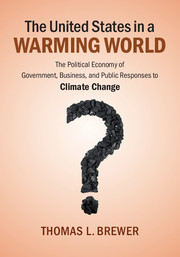 The United States in a Warming World
The United States in a Warming World Book contents
Introduction: a chronological overview
Published online by Cambridge University Press: 05 October 2014
Summary
Responses in the USA to climate change have extended over more than a half century – starting with concern among a small number of scientists in the 1950s. Over time the number and diversity of people who have become attentive to the problem have increased dramatically. This Introduction highlights landmark events and other developments along the way, including those that affected the context in which climate change issues have arisen as well as those that have entailed direct action.
The chronology emphasizes US presidential and congressional decisions, but it also includes public opinion, business, court cases, state and local governments, international conferences, and particularly significant climate science developments and extreme weather events. The context and significance of the events are discussed in much more detail in various chapters.
1950s–1960s
After nearly a century of attention to climate change by mostly European scientists, climatologists in theUnited States began to give itmore serious attention in the 1950s. As part of the Eisenhower administration’s contribution to the International Geophysical Year in 1957, scientist Charles Keeling took repeated measurements of atmospheric carbon dioxide concentrations inHawaii; he found a trend over a few years of increasing concentrations and seasonal patterns of relatively high concentrations in the fall and winter and low in the spring and summer, when trees absorb more carbon dioxide (Keeling 1960). The Keeling curve depicting these measurements has since become an icon of climatology, and it has been regularly updated (see Figure I.1). In addition, the work of Roger Revelle and Hans Suess (1957) contributed to increased interest among American scientists during this period.
- Type
- Chapter
- Information
- The United States in a Warming WorldThe Political Economy of Government, Business, and Public Responses to Climate Change, pp. 1 - 12Publisher: Cambridge University PressPrint publication year: 2014


